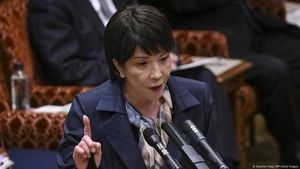South Africa’s currency, the rand, has been on a dramatic ride in 2025, battered by global trade squalls and buoyed by moments of surprising resilience. As of October 14, the rand stands at around R17.30 to the US dollar, a marked improvement from its starting point of R18.82 at the beginning of the year. But behind these numbers lies a tale of international tensions, shifting economic strategies, and a nation’s efforts to find its footing amid global uncertainty.
The latest turbulence for the rand stems from renewed trade tensions between the United States and China, which have sent shockwaves through financial markets worldwide. According to Daily Investor, the United States, under President Donald Trump, has oscillated between threatening increased tariffs on Chinese imports and then backpedaling, creating a climate of unpredictability. This seesawing approach has not only rattled the Chinese and American economies but also left South Africa—one of China’s major trading partners—caught in the crossfire.
Investec chief economist Annabel Bishop explained, “The US has vacillated between renewed threats on increased tariffs for China, then backpedalling on these, creating uncertainty for financial markets.” She noted that this uncertainty has recently strengthened the US dollar, causing the rand to weaken to R17.50/USD before recovering slightly to R17.30/USD as of October 14. “The rand neared R17.00/USD last week but weakened to R17.50/USD on Friday, before recovering somewhat today to R17.30/USD on the US’s more conciliatory tone, but volatility is likely to persist, and unpredictability in US policy,” Bishop said.
It’s not just the US-China standoff that’s roiling the waters. The United States government shutdown, now in its fourteenth day, has added another layer of uncertainty. As Bishop observed, “US policy remains unpredictable, with no certainty that this will subside, despite market expectations of a more predictable year in 2026.” The shutdown has raised the specter of layoffs for some public officials, further clouding the economic outlook and contributing to market volatility.
The trade war between the US and China, which flared anew at the start of 2025, saw tariffs soar to as high as 145% on certain goods. While a temporary deal eased tensions, the peace proved short-lived. The US recently threatened to impose 100% tariffs on Chinese goods, prompting a stern warning from China. A spokesperson for China’s commerce ministry declared, “China’s position on the trade war is consistent. We do not want it, but we are not afraid of it. If the United States insists on going the wrong way, China will surely take resolute measures to protect its legitimate rights and interests.”
President Trump, for his part, struck a reassuring note on Truth Social, posting, “Don’t worry about China, it will be all fine!” Yet, as Reuters reported, investors remain skeptical, with Asian stocks stumbling on October 14 amid doubts about whether the two superpowers can reach a lasting agreement. The Johannesburg Stock Exchange Top-40 index, however, bucked the trend, rising 0.8% on October 13, as South African markets found support in record gold prices. Gold soared above $4,100 an ounce on October 14, driven by expectations of US Federal Reserve rate cuts and renewed safe-haven demand amid global uncertainty. Silver wasn’t left out either, hitting an all-time peak the same day.
Beyond the headlines of global trade, South Africa is grappling with its own set of challenges and opportunities. On October 14, Deputy Trade Minister Zuko Godlimpi addressed an event in Johannesburg, urging the country to diversify its trade relationships. “Our export basket remains too concentrated on a handful of markets and too dependent on raw materials rather than value-added products,” Godlimpi said, as reported by Bloomberg. Drawing on a vivid metaphor, he added, “Like a butterfly that pollinates multiple flowers, South Africa must establish trade flows across every continent.” Godlimpi specifically highlighted opportunities for expanding trade with Southeast Asia as a response to the US-imposed 30% tariffs on some South African goods.
These tariffs, announced by President Trump, have forced South Africa to confront the risks of overreliance on a few major markets. Godlimpi’s call for a broader, more balanced export footprint comes at a critical juncture, as the nation’s trade and industrial sectors face pressure from both external shocks and internal constraints. On the domestic front, South Africa’s trade minister has warned that local smelters need electricity subsidies to survive, underscoring the challenges facing the country’s manufacturing base.
Yet, amid the volatility and uncertainty, there are signs of underlying strength. Reserve Bank Governor Lesetja Kganyago recently offered a more optimistic perspective on the rand’s trajectory. Speaking at the Kgalema Motlanthe Foundation’s Drakensberg Inclusive Growth Forum, Kganyago remarked that the rand is entering a “more mature stage of life.” He pushed back against the common perception that the currency is inherently weak and volatile. “When people tell you the rand is a weak and volatile currency, encourage them to think again,” he urged. “I would also like more people to recognise that rand volatility has declined. Option-implied volatility is now at long-term lows.”
Kganyago attributed this greater stability, in part, to South Africa’s shift toward lower inflation. The Reserve Bank and National Treasury have been in discussions about lowering the official inflation target from its current range of 3% to 6% to a preferred 3%, aligning more closely with international peers. “As we have often argued, our inflation rate is out of line with our peers and competitors. Most advanced economies target 2%,” Kganyago explained. “Emerging markets used to be much higher, but nowadays they commonly target rates between 2% and 4%, with a middle-income median of 3%.”
He went on to explain the rationale behind this shift: “We have stuck with a 3% to 6% target range for 25 years – a quarter of a century – but this range is too high and too broad. It has left us as inflation outliers.” According to Kganyago, aiming for a high inflation rate means South Africa’s prices rise faster than those of other countries, forcing the rand to depreciate to maintain competitiveness. “The result is a kind of ‘damned-if-you-do, damned-if-you-don’t’ trap: either you get a perennially weaker currency, with all its disappointments, or you don’t, and you lose competitiveness. This no longer applies if you have an inflation close to that of your peers – as we now do.”
The Reserve Bank’s push for a lower inflation target is not just about currency stability. Kganyago and his team argue that it would bring broader benefits, including lower long-term inflation and interest rates, and would support the government’s efforts to stabilize its debt trajectory. While no official change has been announced, the July 2025 Monetary Policy Committee meeting made clear the central bank’s preference for a 3% target.
As South Africa navigates the choppy waters of global trade, persistent currency volatility, and domestic reform, its leaders are betting that a more stable rand, a diversified export strategy, and prudent monetary policy will help the country weather the storms ahead. The coming months will test whether these efforts are enough to secure lasting economic resilience—or whether new shocks lie just beyond the horizon.




